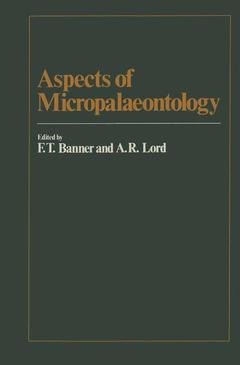Description
Aspects of Micropalaeontology, Softcover reprint of the original 1st ed. 1982
Authors: Banner , Lord
Language: English
Subjects for Aspects of Micropalaeontology:
Keywords
Approximative price 52.74 €
In Print (Delivery period: 15 days).
Add to cart
Publication date: 03-2012
324 p. · 15.5x23.5 cm · Paperback
324 p. · 15.5x23.5 cm · Paperback
Description
/li>Contents
/li>
This volume is a collection of papers presented to Professor Tom Barnard by former students, colleagues and friends to mark thirty-two years of teaching and research in micropalaeontology at University College London. This period represents the major part of Tom Barnard's career with microfossils, which actually began rather earlier, but in 1949 his first postgraduate students were registered. Since then some 150 students have worked for higher degrees studying foraminifera, ostracods, calcareous nannofossils, dino of Research flagellates and palynomorphs, in company with a series Assistants and Visiting Scientists. The nature of micropalaeontology at 'UC' under Tom Barnard has always been unashamedly biostratigraphical. As a result many students have entered and continue to enter the petroleum industry, not least of all because their mentor has always had a pragmatic view of academic research and its direction. Despite this emphasis, with a particular attention to Mesozoic foraminifera, a major investigation of Recent Caribbean foraminiferal faunas has been carried out and most recently MSc classes have worked with material from the continental shelf of southern Africa. Work with Mesozoic ostracods was initiated in 1956 and during the past decade a growing number of students have concentrated on calcareous nannofossils. A book sum marising the results of biostratigraphical work with nannofossils is at present in the press (Lord, A. R. (ed. ) A stratigraphical index of calcareous nanno fossils. Chichester: Ellis Horwood).
1 Architecture and evolution of the foraminiferid test — a theoretical approach.- The models.- Non-septate contained growth.- Non-septate continuous growth.- Septate growth.- Conclusions.- References.- 2 The subgeneric classification of Arenobulimina.- Systematics.- Evolutionary lineages.- Acknowledgements.- References.- Plates.- 3 Middle Eocene assilinid foraminifera from Iran.- Descriptive micropalaeontology.- Acknowledgements.- References.- Plates.- 4 Ecology and distribution of selected foraminiferal species in the North Minch Channel, northwestern Scotland.- Geographic position and regional climate.- Hydrographic conditions and their effect on the distribution of foraminifera.- Distribution of sediment types in the North Minch Channel.- The relationship between foraminiferal shell form and substrate type.- Distribution of selected foraminiferal species.- Generic distributions and dominance.- Conclusions.- Acknowledgements.- References.- Appendix: Total benthonic foraminiferal species recorded in the North Minch Channel.- Plates.- 5 A classification and introduction to the Globigerinacea.- The genera and subgenera of the Globigerinacea.- Nominally available names of the genus-group.- Appended notes: other generic names which have been applied.- Key to the discrimination of globigerinacean genera.- Review and discussion.- Acknowledgements.- References.- 6 Differential preservation of foraminiferids in the English Upper Cretaceous — consequential observations.- Collection and preparation of materials.- Comparative analysis of chalk and flint meal preparations.- Differential loss of planktonic foraminiferids.- Differential loss of benthonic foraminiferids.- Other evidence in relation to selective preservation.- Discussion.- Timing of dissolution.- Selective destruction of planktonic foraminiferids.- Selective survival of the Textulariina.- Depth of the Chalk sea.- Interpretative use of fossil foraminiferid assemblages page.- Conclusions.- Acknowledgements.- References.- 7 Metacopine ostracods in the Lower Jurassic.- Zonal biostratigraphy.- The extinction of the Metacopina.- Discussion.- Acknowledgements.- References.- Appendix: Bilecik, Turkey.- 8 Palynofacies and salinity in the Purbeck and Wealden of southern England.- Geology.- Purbeck Beds palynofacies.- Hastings Beds palynofacies.- Weald Clay palynofacies.- Wealden Marls and Wealden Shales palynofacies, Isle of Wight.- Conclusion.- Acknowledgements.- References.- Plates.- Appendix: Past and present students of micropalaeontology at University College London.- General index.- Taxonomic index.
© 2024 LAVOISIER S.A.S.




